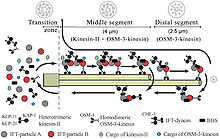
Back Unutarflagelski transport BS Transporte intraflagelar Spanish Интрафлагеллярный транспорт Russian

Intraflagellar transport (IFT) is a bidirectional motility along axoneme microtubules that is essential for the formation (ciliogenesis) and maintenance of most eukaryotic cilia and flagella.[1] It is thought to be required to build all cilia that assemble within a membrane projection from the cell surface. Plasmodium falciparum cilia and the sperm flagella of Drosophila are examples of cilia that assemble in the cytoplasm and do not require IFT. The process of IFT involves movement of large protein complexes called IFT particles or trains from the cell body to the ciliary tip and followed by their return to the cell body. The outward or anterograde movement is powered by kinesin-2 while the inward or retrograde movement is powered by cytoplasmic dynein 2/1b. The IFT particles are composed of about 20 proteins organized in two subcomplexes called complex A and B.[2]
IFT was first reported in 1993 by graduate student Keith Kozminski while working in the lab of Dr. Joel Rosenbaum at Yale University.[3][4] The process of IFT has been best characterized in the biflagellate alga Chlamydomonas reinhardtii as well as the sensory cilia of the nematode Caenorhabditis elegans.[5]
It has been suggested based on localization studies that IFT proteins also function outside of cilia.[6]
- ^ "The Panda's Thumb: Of cilia and silliness (More on Behe)". www.pandasthumb.org. Archived from the original on 14 September 2007. Retrieved 13 January 2022.
- ^ Cole, DG; Diener, DR; Himelblau, AL; Beech, PL; Fuster, JC; Rosenbaum, JL (May 1998). "Chlamydomonas kinesin-II-dependent intraflagellar transport (IFT): IFT particles contain proteins required for ciliary assembly in Caenorhabditis elegans sensory neurons". J. Cell Biol. 141 (4): 993–1008. doi:10.1083/jcb.141.4.993. PMC 2132775. PMID 9585417.
- ^ Bhogaraju, S.; Taschner, M.; Morawetz, M.; Basquin, C.; Lorentzen, E. (2011). "Crystal structure of the intraflagellar transport complex 25/27". The EMBO Journal. 30 (10): 1907–1918. doi:10.1038/emboj.2011.110. PMC 3098482. PMID 21505417.
- ^ Kozminski, KG; Johnson KA; Forscher P; Rosenbaum JL. (1993). "A motility in the eukaryotic flagellum unrelated to flagellar beating". Proc Natl Acad Sci U S A. 90 (12): 5519–23. Bibcode:1993PNAS...90.5519K. doi:10.1073/pnas.90.12.5519. PMC 46752. PMID 8516294.
- ^ Orozco, JT; Wedaman KP; Signor D; Brown H; Rose L; Scholey JM (1999). "Movement of motor and cargo along cilia". Nature. 398 (6729): 674. Bibcode:1999Natur.398..674O. doi:10.1038/19448. PMID 10227290. S2CID 4414550.
- ^ Sedmak T, Wolfrum U (April 2010). "Intraflagellar transport molecules in ciliary and nonciliary cells of the retina". J. Cell Biol. 189 (1): 171–86. doi:10.1083/jcb.200911095. PMC 2854383. PMID 20368623.